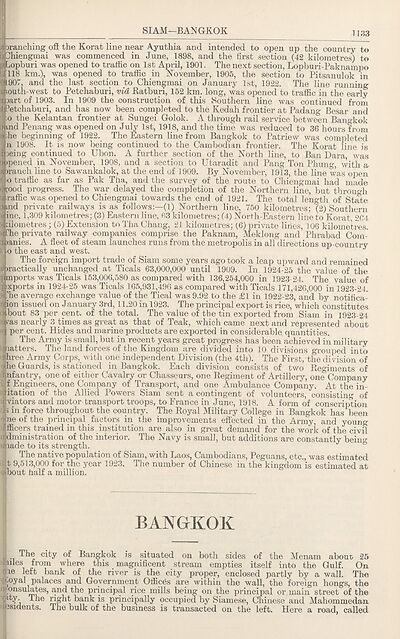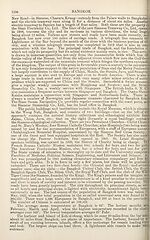1926
(1200) Page 1133 - Bangkok
Download files
Complete book:
Individual page:
Thumbnail gallery: Grid view | List view

SIAM—BANGKOK
1133
branching ofl the Korat line near Ayuthia and intended to open up the country to
Dhiengmai was commenced in June, 1898, and the first section (42 kilometres) to
Lopburi was opened to traffic on 1st April, 1901. The next section, Lopburi-Paknampo
:il8 km.), was opened to traffic in November, 1905, the section to Pitsanulok in
.907, and the last section to Chiengmai on January 1st, 1922. The line running
iouth-west to Petchaburi, vid ftatburi, 152 km. long, was opened to traffic in the early
□art of 1903. In 1909 the construction of this Southern line was continued from
r’etchaburi, and has now been completed to the Kedah frontier at Padang Besar and
;o the Kelantan frontier at Sungei Golok. A through rail service between Bangkok
md Penang was opened on July 1st, 1918, and the time was reduced to 36 hours from
he beginning of 1922. The Eastern line from Bangkok to Patriew was completed
n 1908. It is now being continued to the Cambodian frontier. The Korat line is
aeing continued to Ubon. A further section of the North line, to Ban Dara, was
>pened in November, 1908, and a section to Utaradit and Pang Ton Phung, with a
>ranch line to Sawankalok, at the end of 1909. By November, 1913, the line was open
«traffic as far as Pak Tha, and the survey of the route to Chiengmai had made
;ood progress. The war delayed the completion of the Northern line, but through
raffle was opened to Chiengmai towards the end of 1921. The total length of State
md private railways is as follows:—(1) Northern line, 750 kilometres; (2) Southern
Ine, 1,309 kilometres; (3) Eastern line, 63 kilometres; (4) North-Eastern line to Korat, 264
dloinetres; (5) Extension to Tha Chang, 21 kilometres: (6) private lines, 106 kilometres.
Che private railway companies comprise the Paknam, Meklong and Phrabad Com-
)anies. A fleet of steam launches runs from the metropolis in all directions up-country
o the east and west.
■ The foreign import trade of Siam some years ago took a leap upward and remained
tractically unchanged at Ticals 63,000,000 until 1909. In 1924-25 the value of the
mports was Ticals 153,006,580 as compared with 136,254,000 in 1923-24. The value of
xports in 1924-25 was Ticals 165,931,496 as compared with Ticals 171,426,000 in 1923-24.
’he average exchange value of the Tical was 9.92 to the £1 in 1922-23, and by notifica-
ion issued on January 3rd, 11.20 in 1923. The principal export is rice, which constitutes
bout 83 per cent, of the total. The value of the tin exported from Siam in 1923-24
ras nearly 3 times as great as that of Teak, which came next and represented about
per cent. Hides and marine products are exported in considerable quantities.
- The Army is small, but in recent year’s great progress has been achieved in military
latters. The land forces of the Kingdom are divided into 10 divisions grouped into
hree Army Corps, with one independent Division (the 4th). The First, the division of
he Guards, is stationed in Bangkok. Each division consists of two Regiments of
nfantry, one of either Cavalry or Chasseurs, one Regiment of Artillery, one Company
f Engineers, one Company of Transport, and one Ambulance Company. At the in¬
itiation of the Allied Powers Siam sent a contingent of volunteers, consisting of
viators and motor transport troops, to France in June, 1918. A form of conscription
3 in force throughout the country. The Royal Military College in Bangkok has been
ne of the principal factors in the improvements effected in the Army, and young
fficers trained in this institution are also in great demand for the work of the civil
dministration of the interior. The Navy is small, but additions are constantly being
lade to its strength.
The native population of Siam, with Laos, Cambodians, Peguans, etc., was estimated
t 9,513,000 for the year 1923. The number of Chinese in the kingdom is estimated at
bout half a million.
BANGKOK
The city of Bangkok is situated on both sides of the Menam about 25
ales from where this magnificent stream empties itself into the Gulf. On
;ie left bank of the river is the city proper, enclosed partly by a wall. The
;oyal palaces and Government Offices are within the wall, the foreign hongs, the
lonsulates, and the principal rice mills being on the principal or main street of the
• j bank is principally occupied by Siamese, Chinese and Mahommedan.
ssiaents. The bulk of the business is transacted on the left. Here a road, called
1133
branching ofl the Korat line near Ayuthia and intended to open up the country to
Dhiengmai was commenced in June, 1898, and the first section (42 kilometres) to
Lopburi was opened to traffic on 1st April, 1901. The next section, Lopburi-Paknampo
:il8 km.), was opened to traffic in November, 1905, the section to Pitsanulok in
.907, and the last section to Chiengmai on January 1st, 1922. The line running
iouth-west to Petchaburi, vid ftatburi, 152 km. long, was opened to traffic in the early
□art of 1903. In 1909 the construction of this Southern line was continued from
r’etchaburi, and has now been completed to the Kedah frontier at Padang Besar and
;o the Kelantan frontier at Sungei Golok. A through rail service between Bangkok
md Penang was opened on July 1st, 1918, and the time was reduced to 36 hours from
he beginning of 1922. The Eastern line from Bangkok to Patriew was completed
n 1908. It is now being continued to the Cambodian frontier. The Korat line is
aeing continued to Ubon. A further section of the North line, to Ban Dara, was
>pened in November, 1908, and a section to Utaradit and Pang Ton Phung, with a
>ranch line to Sawankalok, at the end of 1909. By November, 1913, the line was open
«traffic as far as Pak Tha, and the survey of the route to Chiengmai had made
;ood progress. The war delayed the completion of the Northern line, but through
raffle was opened to Chiengmai towards the end of 1921. The total length of State
md private railways is as follows:—(1) Northern line, 750 kilometres; (2) Southern
Ine, 1,309 kilometres; (3) Eastern line, 63 kilometres; (4) North-Eastern line to Korat, 264
dloinetres; (5) Extension to Tha Chang, 21 kilometres: (6) private lines, 106 kilometres.
Che private railway companies comprise the Paknam, Meklong and Phrabad Com-
)anies. A fleet of steam launches runs from the metropolis in all directions up-country
o the east and west.
■ The foreign import trade of Siam some years ago took a leap upward and remained
tractically unchanged at Ticals 63,000,000 until 1909. In 1924-25 the value of the
mports was Ticals 153,006,580 as compared with 136,254,000 in 1923-24. The value of
xports in 1924-25 was Ticals 165,931,496 as compared with Ticals 171,426,000 in 1923-24.
’he average exchange value of the Tical was 9.92 to the £1 in 1922-23, and by notifica-
ion issued on January 3rd, 11.20 in 1923. The principal export is rice, which constitutes
bout 83 per cent, of the total. The value of the tin exported from Siam in 1923-24
ras nearly 3 times as great as that of Teak, which came next and represented about
per cent. Hides and marine products are exported in considerable quantities.
- The Army is small, but in recent year’s great progress has been achieved in military
latters. The land forces of the Kingdom are divided into 10 divisions grouped into
hree Army Corps, with one independent Division (the 4th). The First, the division of
he Guards, is stationed in Bangkok. Each division consists of two Regiments of
nfantry, one of either Cavalry or Chasseurs, one Regiment of Artillery, one Company
f Engineers, one Company of Transport, and one Ambulance Company. At the in¬
itiation of the Allied Powers Siam sent a contingent of volunteers, consisting of
viators and motor transport troops, to France in June, 1918. A form of conscription
3 in force throughout the country. The Royal Military College in Bangkok has been
ne of the principal factors in the improvements effected in the Army, and young
fficers trained in this institution are also in great demand for the work of the civil
dministration of the interior. The Navy is small, but additions are constantly being
lade to its strength.
The native population of Siam, with Laos, Cambodians, Peguans, etc., was estimated
t 9,513,000 for the year 1923. The number of Chinese in the kingdom is estimated at
bout half a million.
BANGKOK
The city of Bangkok is situated on both sides of the Menam about 25
ales from where this magnificent stream empties itself into the Gulf. On
;ie left bank of the river is the city proper, enclosed partly by a wall. The
;oyal palaces and Government Offices are within the wall, the foreign hongs, the
lonsulates, and the principal rice mills being on the principal or main street of the
• j bank is principally occupied by Siamese, Chinese and Mahommedan.
ssiaents. The bulk of the business is transacted on the left. Here a road, called
Set display mode to:
![]() Universal Viewer |
Universal Viewer | ![]() Mirador |
Large image | Transcription
Mirador |
Large image | Transcription
Images and transcriptions on this page, including medium image downloads, may be used under the Creative Commons Attribution 4.0 International Licence unless otherwise stated. ![]()
| Asian directories and chronicles > 1926 > (1200) Page 1133 - Bangkok |
|---|
| Permanent URL | https://digital.nls.uk/196503773 |
|---|
| Attribution and copyright: |
|
|---|---|
| Description | Volumes from the Asian 'Directory and Chronicle' series covering 1917-1941, but missing 1919 and 1923. Compiled annually from a multiplicity of local sources and research. They provide listings of each country's active corporations, foreign residents and government agencies of all nationalities for that year, together with their addresses. Content includes: various treaties; coverage of conflicts; currencies and taxes; consular fees; weights and measures; public holidays; festivals and traditions. A source of information for both Western states and communities of foreigners living in Asia. Published by Hongkong Daily Press. |
|---|---|
| Shelfmark | H3.86.1303 |
| Additional NLS resources: |
![[Page 1132]Siam](https://deriv.nls.uk/dcn4/1965/0376/196503762.4.jpg)
